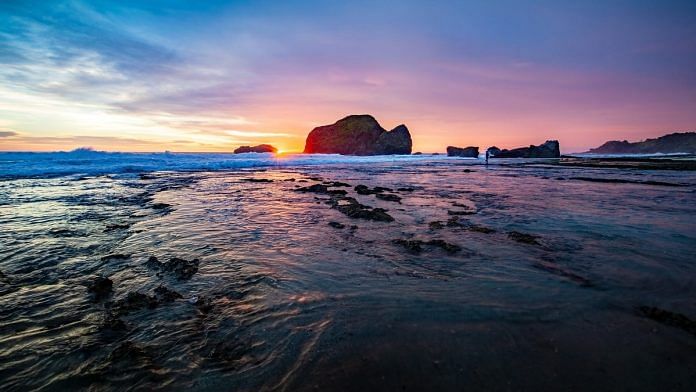‘Volcanic province’ in Indian Ocean spewed lava for 30 million years
Scientists have discovered a ‘volcanic province’ in the Indian Ocean that was the world’s most continuously-active — erupting for 30 million years — fuelled by a constantly moving ‘conveyor belt’ of magma.
The magma conveyor belt, created by shifts in the seabed, continuously made space available for the molten rock to flow for millions of years, beginning around 120 million years ago.
The volcanoes were in the Kerguelen Plateau, located in the Indian Ocean, about 3,000 km south west of Fremantle, Western Australia.
Volcanic provinces are large accumulations of volcanic rocks that are often linked to mass extinctions, rapid climatic disturbances, and ore deposit formation.
The Kerguelen Plateau is gigantic and erupted at a rate of about 20 cm every year. That is equivalent to filling up 184,000 Olympic-size swimming pools with lava every single year.
This volume of activity continued for 30 million years, making the Kerguelen Plateau home to the longest continuously erupting supervolcanoes on Earth. The eruption rates then dropped drastically some 90 million years ago, for reasons that are not yet fully understood. More on Express.
Also read: Astronomers detect first fast radio burst in our Milky Way galaxy
Milky Way may be home to 300 million potentially habitable worlds
The Milky Way galaxy holds at least an estimated 300 million potentially habitable worlds, a new NASA study suggests.
Based on data from NASA’s retired planet-hunting mission, the Kepler space telescope, researchers conclude that about half the stars that have temperatures similar to the Sun could have a rocky planet capable of supporting liquid water on its surface.
Some of these exoplanets could even be our interstellar neighbours, with at least four planets within 30 light-years of our Sun. The closest of these is likely to be about 20 light-years from us.
The findings are a significant step forward in Kepler’s original mission to understand how many potentially habitable worlds exist in our galaxy. Previous estimates of the frequency of such planets ignored the relationship between the star’s temperature and the kinds of light given off by the star and absorbed by the planet. More on the New York Times.
New mineral discovered in moon meteorite
Scientists have discovered a new mineral on a lunar meteorite, which was ejected from the moon as a result of an impact and subsequently delivered to the earth.
Named donwilhelmsite, it is a high-pressure mineral mainly composed of calcium, aluminum, silicon, and oxygen atoms. Donwilhelmsite was in the lunar meteorite Oued Awlitis 001 found in 2014 in western Sahara. By composition, this meteorite is similar to rocks comprising the Earth’s continents.
Eroded sediments from these continents are transported by wind and rivers to the oceans, and pushed under the Earth’s mantle as part of the dense oceanic crust. While being dragged deeper into the Earth mantle the pressure and temperature increases, and the minerals transform into denser mineral phases.
The newly discovered mineral donwilhelmsite forms in 460 to 700 km depth. In the terrestrial rock cycle, donwilhelmsite is therefore an important agent for transporting crustal sediments through the transition zone separating the upper and lower Earth’s mantle. More on SciTech Daily.
Also read: Yes, she did — New findings show prehistoric women hunted too
Asteroid following Mars may be an ancient piece of moon
An asteroid trailing Mars may actually be a piece of debris dating back to the gigantic impacts that formed the moon and other rocky planets in our solar system like Mars and the Earth, a new study suggests.
Scientists have found that the composition of trojan — a class of asteroid that follows the planets in their orbits — is very similar to the moon’s.
Trapped within gravitational “safe havens” 60 degrees in front of and behind the planet, trojans are great interest to scientists as they represent leftover material from the formation and early evolution of the solar system.
Thousands of those trojans exist along the orbit of the giant planet Jupiter. Closer to the Sun, astronomers have so far discovered only a handful of trojans of Mars. More on Live Science.
Plant-eating dinosaurs may have swum across oceans to get to Africa
Duck-billed dinosaurs crossed hundreds of kilometres of open water to get to Africa from North America, say scientists who have discovered the first fossils of a member of the prehistoric species in Africa.
The fossils of the dinosaur, Ajnabia Odysseus, were found in rocks in Morocco dating to 66 million years ago. Ajnabia was a member of the duckbill dinosaurs, diverse plant-eating dinosaurs that grew up to 15 meters long. However, Ajnabia was just about 3 meters long.
Duckbills evolved in North America and eventually spread to South America, Asia, and Europe. Since Africa was an island continent in that period, isolated by deep seaways, it appeared impossible for duckbills to get there.
The discovery of the new fossil in a mine a few hours from Casablanca was thus unexpected.
The duckbills must have crossed hundreds of kilometres of open water — rafting on debris, floating, or swimming — to travel to Africa.
Duckbills were probably powerful swimmers — they had large tails and powerful legs, and are often found in river deposits and marine rocks, so they may have simply swum the distance. More on CNN.
Also read: Can plant traits be modified without modifying their DNA? Netherlands study says yes



